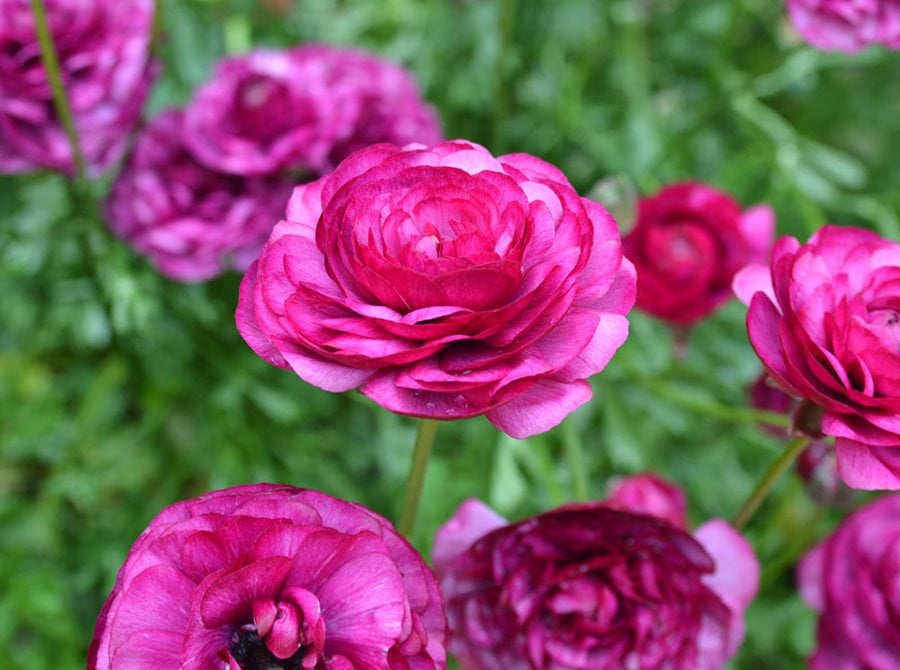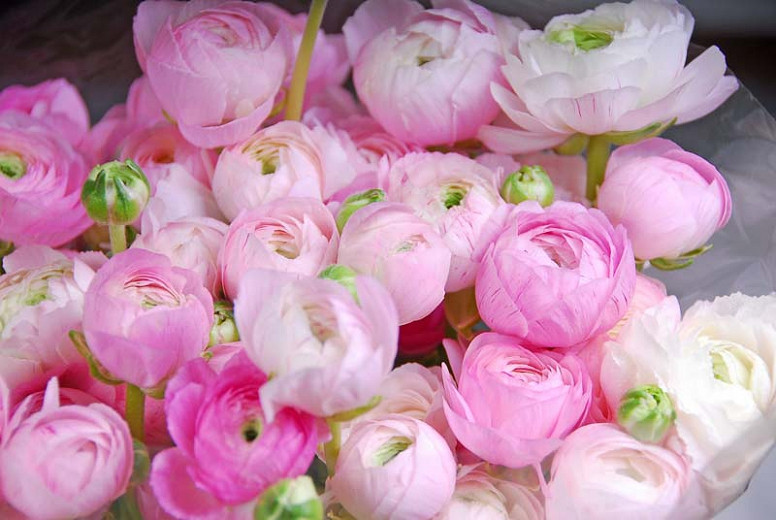The Captivating Ranunculus: A Deep Dive into the Persian Buttercup
:max_bytes(150000):strip_icc()/s-p-r-i-n-g---f-e-v-e-r-98452121-5590d92b04154ec791ded2321ec942ea.jpg)
The ranunculus, often referred to as the Persian buttercup, is a captivating flower prized for its densely petaled, almost otherworldly beauty. With its layers upon layers of delicate, paper-thin petals, it’s no wonder the ranunculus has become a popular choice for bouquets, gardens, and even wedding arrangements. Beyond its aesthetic appeal, however, lies a rich history, diverse range of varieties, and a fascinating cultivation process. This article delves into the world of the ranunculus, exploring its origins, characteristics, cultivation tips, and more.
A Journey Through Time: The History and Symbolism of Ranunculus
The ranunculus genus, Ranunculus, is a vast one encompassing over 600 species. However, when we speak of the ranunculus in the context of floristry and gardening, we are generally referring to Ranunculus asiaticus. Native to the Middle East, particularly Persia (modern-day Iran) and the surrounding regions, the ranunculus has a long and storied history.
The exact origins of its cultivation are somewhat hazy, but evidence suggests it was being grown in gardens as early as the 16th century. The flower’s journey to Europe is attributed to Crusaders who brought it back from their travels in the East. It quickly gained popularity, becoming a favorite amongst European gardeners, particularly in England and France.
The Victorian era, with its penchant for assigning symbolic meanings to flowers, saw the ranunculus associated with the message "I am dazzled by your charms." This romantic association, coupled with its exquisite beauty, cemented its place as a flower of admiration and affection.
Unveiling the Beauty: Characteristics and Varieties of Ranunculus
The defining characteristic of the ranunculus is undoubtedly its profusion of petals. These paper-thin petals, often numbering in the hundreds, are tightly packed together, creating a lush, almost spherical flower head. The petals come in a wide array of colors, ranging from pure white and pastel shades of pink, yellow, and orange to vibrant reds, purples, and even bicolors.
The size of the flower head can vary depending on the variety, but generally, they range from 1 to 4 inches in diameter. The stems are typically slender and can grow anywhere from 6 to 18 inches tall, making them ideal for cut flower arrangements.
Over the centuries, breeders have developed numerous cultivars and hybrids of Ranunculus asiaticus, each with its own unique characteristics. Some of the most popular varieties include:
-
Tecolote Ranunculus: This variety is known for its exceptionally large, double blooms and its wide range of colors. It’s a popular choice for cut flower production and is often grown commercially.
-
Cloni Ranunculus: This series, developed in Italy, is prized for its strong stems, long vase life, and vibrant colors. They are highly sought after by florists.

-
Butterfly Ranunculus: This variety features petals that are slightly separated, giving them a more delicate and butterfly-like appearance.

Picotee Ranunculus: These ranunculus are characterized by petals with contrasting edges, creating a striking and unique effect.
-
Double Picotee Ranunculus: A more elaborate version of the Picotee, featuring multiple layers of contrasting color on the petal edges.
:max_bytes(150000):strip_icc()/orange-ranunculus-flowers-1134187762-ae9cbd6f31ac4309b27dda22d241ac3f.jpg)
Cultivating Beauty: Growing Your Own Ranunculus
Growing ranunculus can be a rewarding experience, allowing you to enjoy their beauty firsthand. While they can be a bit challenging to cultivate, following these tips will increase your chances of success:
-
Planting Time: Ranunculus are typically planted in the fall in warmer climates (zones 8-10) and in the spring in colder climates (zones 4-7). The ideal planting time is when the soil temperature is consistently around 60°F (15°C).
-
Choosing the Right Location: Ranunculus thrive in full sun, requiring at least 6 hours of direct sunlight per day. They also need well-draining soil to prevent root rot. Amending the soil with compost or other organic matter will improve drainage and fertility.
-
Preparing the Corms: Ranunculus are grown from corms, which are small, dried, bulb-like structures. Before planting, it’s essential to soak the corms in lukewarm water for 3-4 hours. This will rehydrate them and encourage them to sprout.
-
Planting the Corms: Plant the corms with the "claw" side down, about 1-2 inches deep and 6-8 inches apart. Water thoroughly after planting.
-
Watering and Fertilizing: Keep the soil consistently moist, but avoid overwatering, which can lead to root rot. Once the plants start to grow, fertilize them every 2-3 weeks with a balanced liquid fertilizer.
-
Deadheading: Regularly deadhead spent flowers to encourage more blooms.
-
Pest and Disease Control: Ranunculus can be susceptible to pests such as aphids and spider mites. Monitor your plants regularly and treat any infestations promptly. They can also be prone to fungal diseases, so ensure good air circulation and avoid overhead watering.
-
Overwintering: In colder climates, ranunculus corms need to be lifted from the ground in the fall and stored in a cool, dry place until the following spring. Alternatively, they can be grown as annuals. In warmer climates, they can be left in the ground year-round.
Beyond the Garden: Uses and Applications of Ranunculus
While the ranunculus is primarily valued for its ornamental beauty, it has various other uses and applications:
-
Cut Flowers: Ranunculus are a popular choice for cut flower arrangements due to their long vase life and vibrant colors. They are often used in bouquets, centerpieces, and wedding arrangements.
-
Gardening: Ranunculus add a touch of elegance and sophistication to any garden. They can be planted in borders, containers, or mass plantings.
-
Medicinal Uses: In traditional medicine, some species of ranunculus have been used for their anti-inflammatory and analgesic properties. However, it’s important to note that ranunculus plants contain toxins and should be handled with caution. Never ingest any part of the plant without consulting a qualified medical professional.
-
Symbolic Meaning: As mentioned earlier, the ranunculus symbolizes charm and attractiveness. It is often given as a gift to express admiration or affection.
FAQ: Frequently Asked Questions About Ranunculus
-
Are ranunculus easy to grow? While they require some specific care, ranunculus can be successfully grown with attention to soil drainage, sunlight, and proper watering.
-
When is the best time to plant ranunculus? Fall planting is recommended in warmer climates (zones 8-10), while spring planting is preferred in colder climates (zones 4-7).
-
Do ranunculus need full sun? Yes, ranunculus thrive in full sun, requiring at least 6 hours of direct sunlight per day.
-
How often should I water ranunculus? Keep the soil consistently moist, but avoid overwatering.
-
Do I need to fertilize ranunculus? Yes, fertilize them every 2-3 weeks with a balanced liquid fertilizer once they start to grow.
-
How do I store ranunculus corms over winter? Lift the corms in the fall, let them dry completely, and store them in a cool, dry place until spring.
-
Are ranunculus poisonous? Yes, ranunculus plants contain toxins that can cause skin irritation and gastrointestinal upset if ingested. Handle with care and keep away from children and pets.
-
Why are my ranunculus not blooming? Several factors can contribute to this, including insufficient sunlight, poor soil drainage, overwatering, or lack of fertilization.
-
What is the vase life of ranunculus? Ranunculus can last for 7-10 days in a vase if properly cared for. Change the water regularly and trim the stems.
-
Can I grow ranunculus in containers? Yes, ranunculus can be successfully grown in containers as long as the containers have good drainage.
Conclusion: Embracing the Allure of the Ranunculus
The ranunculus, with its captivating beauty and rich history, is a truly remarkable flower. From its origins in the Persian landscapes to its widespread popularity in gardens and floral arrangements around the world, the ranunculus continues to enchant and inspire. While its cultivation may require some attention to detail, the rewards of witnessing its vibrant blooms firsthand are well worth the effort. Whether you’re a seasoned gardener or a flower enthusiast, the ranunculus is a captivating addition to any landscape or bouquet, offering a touch of elegance and charm that is simply irresistible. So, embrace the allure of the ranunculus, and let its beauty brighten your world.
